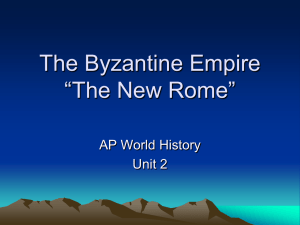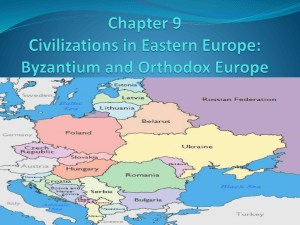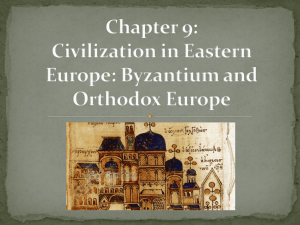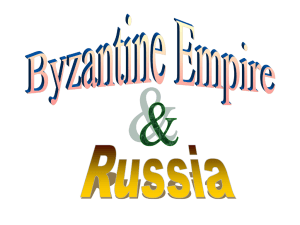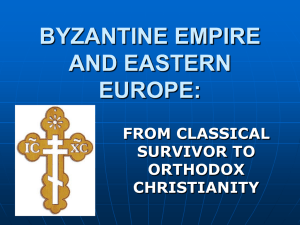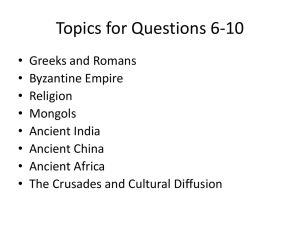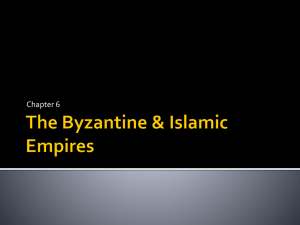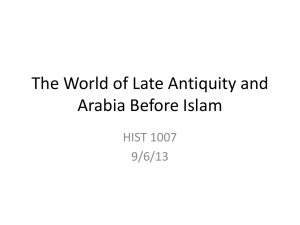The Commonwealth of Byzantium
advertisement
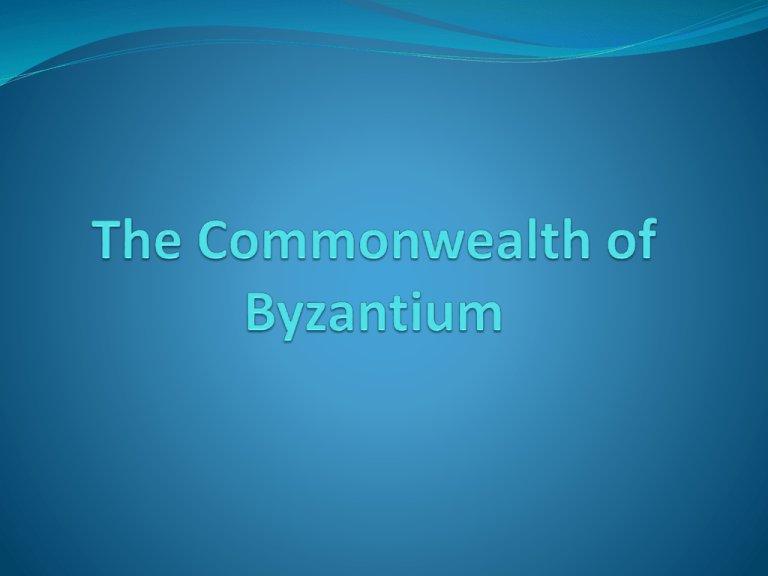
Questions to Consider as You work through this Chapter How did the Byzantine Empire interact with western Europe? How did the Byzantine Empire interact with the rising Islamic World? How did Christianity come to be divided into eastern and western traditions? How did the Byzantine Empire interact with eastern Europe? The Early Byzantine Empire Byzantine Empire – Sometimes called the Byzantine Commonwealth, existed for nearly one thousand years as the “economic and political powerhouse of the postclassical era.” Dominated the wealthy and productive eastern Mediterranean region Led to the formation of large, multicultural zones of trade and communication, and sustained interactions with Slavic, Arab, European, and Asian peoples and traditions. Had readily available overland and sea access to Asia, Europe, and Africa. Capital was Constantinople, later name Istanbul by the Ottoman Turks. The Early Byzantine Empire The Later Roman Empire and Byzantium Early Byzantine Empire, more accurately called the eastern Roman Empire, struggled against pressure from the SASANID Dynasty of Persia and the migratory peoples of the east and north. Survived the fall of western Rome in 476 CE and served as the “powerhouse of the eastern Mediterranean basin” into the 13th century. The Byzantine empire and its neighbors 527-554 C.E. 5 The Early Byzantine Empire The Later Roman Empire and Byzantium Two element of Byzantium more responsible for its survival: Caesaropapism – Gave the emperor absolute secular power and religious power to appoint the patriarch of the Eastern Christian Church (Pope). Elaborate Government Bureaucracy – Large and intricate, essential in enforcing Byzantine laws. The Early Byzantine Empire Justinian and His Legacy Famous for his wife, his building projects, and his laws Theodora – Justinian’s wife and his closest advisor Rebuilt Constantinople and the Church of Hagia Sophia Justinian’s Code (Known as Corpus iuris civilis) – Served as the source of legal inspiration in the Byzantine empire for nearly one thousand years and influenced law codes throughout western Europe as well. Church of Hagia Sophia The Church of Hagia Sophia was coverted into a mosque in 1453. Can you find the Muslim influences? The Church of Hagia Sophia was coverted into a mosque in 1453. Can you find the Muslim influences? Early Byzantine Empire Islamic Conquest and Byzantine Revival By early eighth century, the Byzantines had lost control of Syria, Palestine, Egypt, and North Africa. Got it back through use of the theme system Territories divided into themes ruled by a general who had military and political power and used land to recruit peasants into their armies. Early Byzantine Empire Byzantium and Western Europe Relations were often strained between Byzantium and Western Europe Differences in church language, ecclesiastical practices, and secular ties provoked conflict between these two branches of Christianity. Byzantines maintained their claim to the remains of the Roman empire in the west despite the rising power of Germanic groups, especially Charlemagne and the Franks. Rise of the Holy Roman Empire after 962 severed and antagonized both formerly connected empires. Byzantine Economy and Society Location at a trade crossroads, abundant agricultural surpluses, and the tradition of a strong craft and artisan class formed the basis of a strong economic class. Byzantine Economy and Society Rural economy and society Free peasants who worked on and owned small plots of land formed the basis of the rural economy in Byzantium. Eventually driven off land by wealthier land owners. Economy and Society Industry and Trade Produced glassware, textiles, gems, jewelry, fine gold, and silver metalwork. Smuggled silkworms and silkworm technology from China. Revived trade along the silk road and taxes on goods produced and brought to Byzantine empire made them very wealthy. Economy and Society Urban Life Aristocrats had elaborate homes Artisans and merchants lived in shops Poor lived in tenements or apartment homes Entertainment included horse races, baths, taverns, restaurants, theaters, circuses, and gaming houses. Classical Heritage and Orthodox Christianity Philosophy and literature of classical Greece had a major influence on Christianity in Byzantium. By the mid-eleventh century, differences in doctrine, ritual, and church authority had lead to a formal split between Eastern Orthodox Christianity and Roman Catholic Christianity. Classical Heritage and Orthodox Christianity The Legacy of Classical Greece Greek was the language of Byzantium Most Byzantines had some form of education and the Greek classics formed the basis of much of that education The Byzantine Church Caesaropapism defined the relationship between the church and state in Byzantium. Emperors treated the church as a part of their government Appointed the patriarch of Constantinople and instructed church officials to preach obedience to imperial authority as obedience to God. Monasticism and Popular Piety Orthodox Christianity has a strong tradition of asceticism and monasticism. Monks sought mystical union with God through meditation and prayer. Some orthodox monks and nuns served God by providing social services such as providing food and medical care in times of crisis. Tensions between Eastern and Western Christianity By seventh century only Constantinople and Rome remained as the principal centers of Christian authority. Soon clashed over religious and theological issues Use of icons Type of bread used during communion Whether priests should marry or even shave Relationship between God, Jesus, and the Holy Spirit Language of mass Split between Greek Orthodox and Roman Catholic Church is know as the great schism of east and west and was finalized in 1054 CE. The Byzantine empire and its neighbors 527-554 C.E. 22 Influence of Byzantium in Eastern Europe By the eleventh century, Byzantium was in a period of decline. Surrounded by Islamic and western European societies, Byzantium turned its political, social, and cultural attention to Russia and eastern Europe where it had an enduring impact on the Slavic peoples of that region. The Byzantine empire and its neighbors about 1100 C.E. 24 Byzantium Decline Domestic Problems and Foreign Pressures Reduction in land availability to the free peasants meant fewer recruits available for military service and lower tax revenues for the imperial government. Eventually lead to the end of the Byzantine empire.
